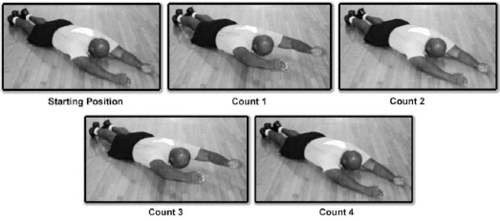The Prone I Raise is a workout exercise that works the upper body, in particular the shoulder and upper back muscles.
The I Raise is the first exercise in the Army Shoulder Stability Drill. The shoulder stability drill is designed to develop strength and stability in the shoulder muscles.
There are four more exercises in the shoulder stability drills:
Prone i Raise Shoulder Stability Drill PRT
Purpose: This exercise develops shoulder strength and stability
I Raise Exercise Instructions:
Cadence: SLOW
- Starting Position:
- Prone position with the head slightly elevated and aligned with the spine.
- Feet are together, and toes are pointed to the rear.
- The arms remain on the ground and are extended overhead, forming an “I” straight in line with the body.
- The hands are in a neutral position (perpendicular to the ground), with the thumbs and fingers extended and joined.
- Count 1:
- On Count one raise both arms 3-6 inches off the ground. while keeping your elbows straight. Your head remains in its starting position.
- Count 2:
- On count two return to the starting position
- Count 3:
- On count three repeat the action of Count One.
- Count 4:
- On count four return to the starting position.
Repetition: Repeat this sequence five times

Check Points:
- At the starting position, tighten the abdominals to stabilize the trunk. The head is slightly elevated and aligned with the spine.
- On counts 1 and 3, keep the back generally straight with the head up.
- Throughout the exercise, the arms should be fully extended and the trunk and legs should also be aligned.
Precaution:
- Keep the head slightly elevated throughout the exercise and do not jerk the body into the up positions on counts 1 and 3.
Here is the exercise as performed in a form at a slow cadence:
Benefits of i Raise Exercise
Below are the key benefits of the Prone I Raise exercise:
- Improved core strength: The Prone I Raise will engage your abdominal muscles, which will help develop a strong core essential for maintaining stability & balance during daily activities.
- Enhanced shoulder stability: This prone raise exercise targets your shoulder muscles, promoting better joint peace and reducing your risk of injury.
- Better posture and balance: In addition to strengthening your core and shoulders, this exercise helps to improve your posture and overall balance, making everyday tasks more accessible and comfortable.
- Increased flexibility: This prone raise exercise stretches your shoulders & upper back muscles, helping promote greater flexibility and range of motion.
I Raise Workout Variations:
Consider incorporating these alternative exercises that target similar muscle groups to keep your workouts exciting and avoid hitting a plateau.
- Alternative Exercise 1: Y Raises: Similar to I Raises, but with arms forming a “Y” at the top of the movement, this exercise targets the upper back and shoulders.
- Alternative Exercise 2: T-Raises: The arms are raised straight out to the sides, forming a “T” shape, focusing on the middle and lower trapezius muscles and the rear deltoids.
Exercise Equipment
Having the proper equipment for the exercise can make all the difference. Here are some suggestions for accessible and affordable options:
- Adjustable dumbbells allow you to increase or decrease the weight as needed, making them versatile.
- Resistance bands: If you prefer a low-impact alternative, resistance bands are a fantastic way to add resistance to your I-raise exercise.
I Raise Fitness Technique
Mastering the I-Raise exercise technique increases efficiency and prevents injuries.
In this section, we will examine the significance of proper technique and common errors to avoid:
- Importance of proper form: Maintaining proper form during the I-Raise exercise ensures you target the appropriate muscle groups and avoid unnecessary joint stress.
- The most common mistakes and how to fix them:
- Common mistakes include hunching your shoulders, bending your elbows, or lifting your arms with momentum.
- To fix these mistakes, keep your shoulders loose, your arms straight, and your core muscles engaged to stay stable.
I Raise Exercise Training
As you get better at the I-Raise exercise, you must keep pushing yourself and progressing. Here are some things you can do to get better at this workout:
- As you become stronger, gradually increase the weight or resistance, or incorporate more difficult exercise variations.
- Set achievable goals for increasing your I-Raise workouts’ intensity, frequency, or duration, and track your progress over time.
- Combine the I Raise exercise with other strength training exercises and cardiovascular activities to create a well-rounded exercise routine.
Exercise for Beginners
Don’t worry if you’ve never done the “I raise” exercise. Start by making these simple changes and following these simple tips to ease into the movement:
- Use lighter or no weights and focus on form and technique.
- Perform the exercise while seated to reduce the difficulty of maintaining balance and to concentrate on the upper body.
- Remember that it is crucial to prioritise form over speed or intensity, so take your time and progress gradually as you become more accustomed to the exercise.
Conclusion :
- Now that you know how the I Raise exercise works and what it can do for you, it’s time to try it!
- Adding this effective workout to your fitness routine can improve your core strength, shoulder stability, posture, and flexibility.
- So start learning how to do the I-Raise exercise right now.
- Empowering Transactions: Navigating Firearms Sales with Proper Documentation - April 8, 2024
- Army PRT – Preparation and Recovery 2024 - March 18, 2024
- Active and Reserve Components 2024 - March 6, 2024
